The best photographs of 2021 – and the stories behind them
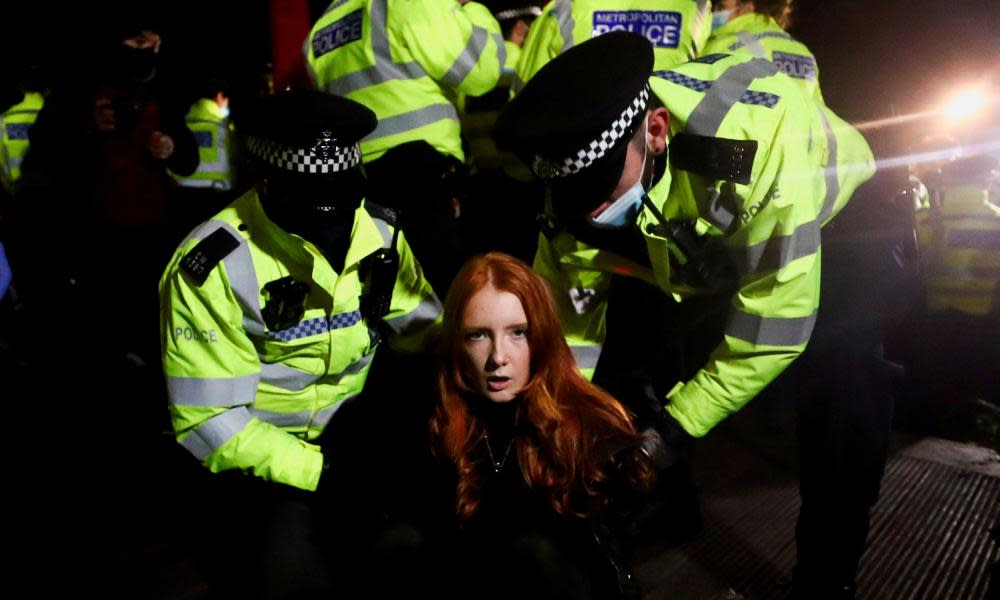
A funeral for Covid victims, Mumbai
Divyakant Solanki/EPA-EFE/Shutterstock
23 April I was staying on the outskirts of Mumbai when news broke that there was a fire in one of the hospitals dealing with Covid patients. I rushed over to find them shifting patients to other hospitals; they said more than 10 people had died already as a result.
The funeral was devastating. There were 10 to 12 Covid victims laid out on the funeral pyre with their relatives gathered around, many of them in tears. Dealing with the emotions of relatives and loved ones is the most difficult part of covering events as a photojournalist.
Civic workers, such as the man in this photo, had a very important role in funerals during Covid – they were the only people allowed to issue last rites. Sadly, there wasn’t nearly enough PPE for relatives to be able to enter the funeral ground or touch the bodies of their dead family members.
This photo is very close to my heart; I have seen so many dead bodies over the past year, but it is difficult to capture the impact that has had on me, let alone the people who have lost relatives. I think seeing a man in PPE, sombrely walking between funeral pyres, shows the human toll of the pandemic. As told to Alex Mistlin
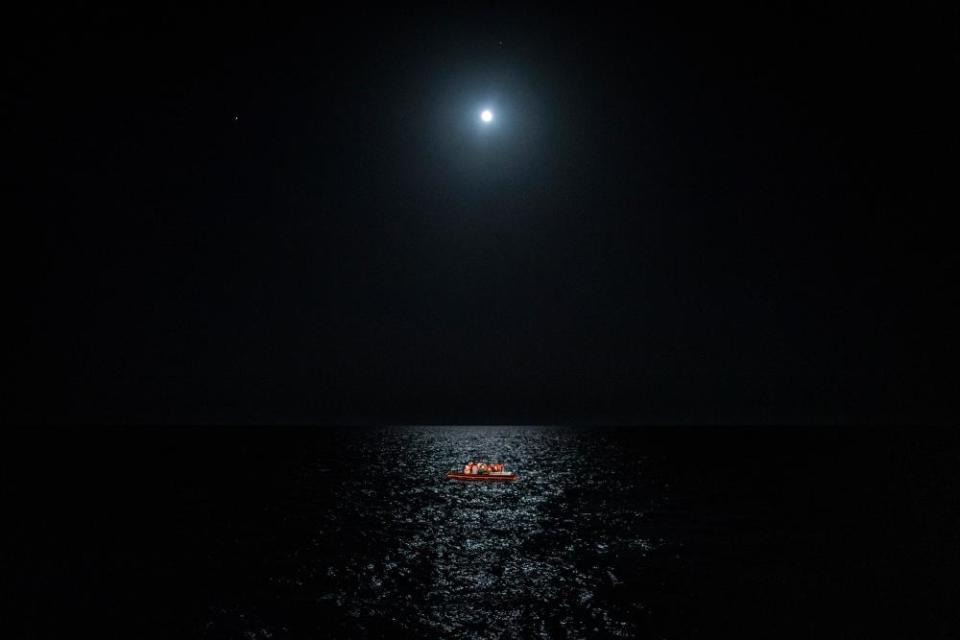
Tunisian people wait for help on a wooden boat, Lampedusa, Italy
Santi Palacios/AP
25 July We were sailing in international waters just south of the island of Lampedusa when we heard fishers calling through the radio, saying there was this small boat with 17 people in it that was taking on water and desperate for help.
The most difficult thing about working at sea is having to work around the rescue operation. The sea route connecting Libya to Italy is one of the deadliest migrant routes in the world. You are in the middle of nowhere, which can be very challenging, especially at night. But when you are lucky and have enough light, or a full moon, you really get the chance to show how lonely the crossings are.
I worry that it is not always apparent how extreme these situations are. People have already seen pictures of refugees drowning in the Mediterranean; everyone knows that it is going on. So, the goal is to take pictures that better convey the intensity of their experiences. AM
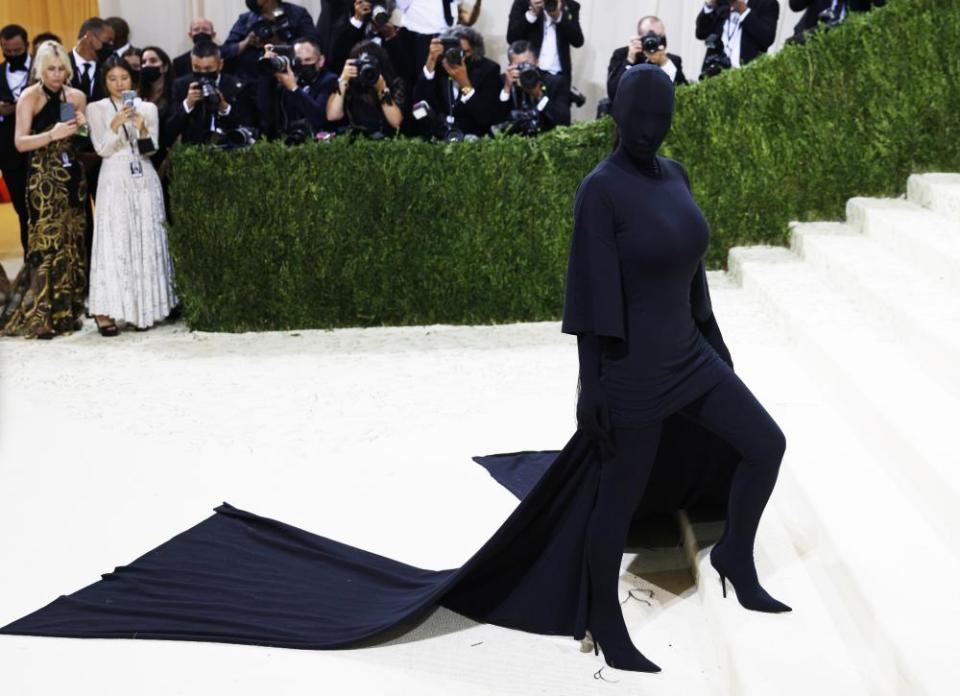
Kim Kardashian at the Met Gala, New York
Justin Lane/EPA
13 September I have been covering the Met Gala for a number of years. It is always a bizarre scene. Any red carpet is exciting, but it is such a weird mix of people: businesspeople, music stars, movie stars. There is a frenetic quality to the whole thing that means you can get two completely random celebrities standing next to each other.
This is a funny picture, in some ways. To have somebody show up in this outfit, totally covered in black – it shows how celebrity is at a weird juncture. Of course, there are plenty of bizarre outfits at the Met Gala – there is a long procession of crazy outfits and celebrities trying to one-up one another – but being covered in black was so different that it caught my attention. Something really wacky, or really sexy, is almost more mundane.
Kim Kardashian is always of great interest to people. It is so much about what she has decided to do in that moment. AM
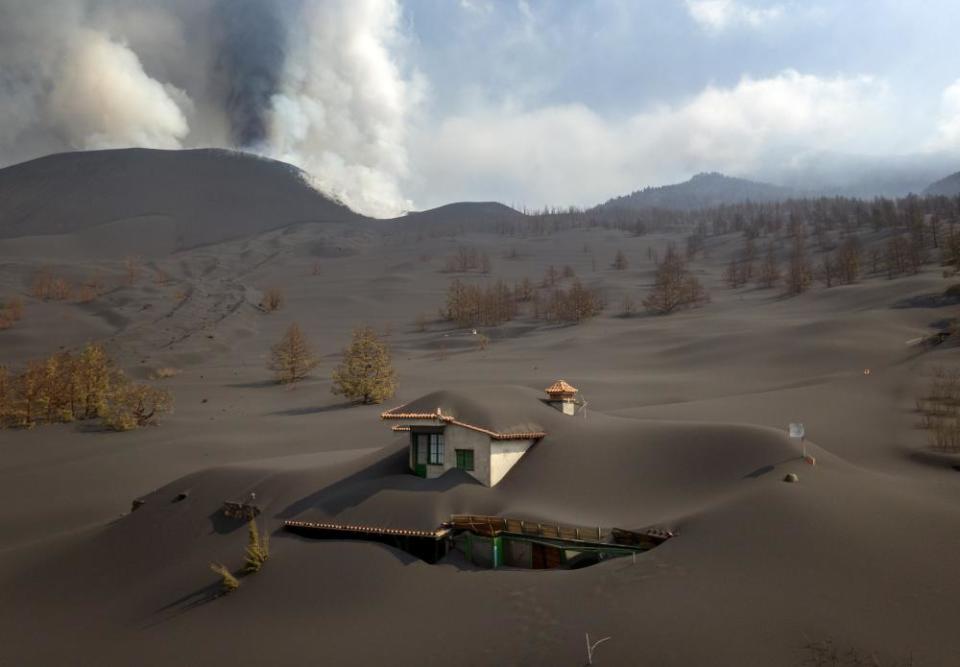
A house covered by ash on La Palma in the Canary Islands, Spain
Emilio Morenatti/AP
30 October The first time I went to La Palma to cover the eruption of the Cumbre Vieja volcano, the exclusion zone was protected by police, which meant I wasn’t able to get close enough. This was taken on my second trip. I spotted a house on the horizon that was completely covered in ash. My first aim was just to go there on foot, but it wasn’t possible, because of the hot rocks and stones rolling down from the volcano. It can be really impersonal using a drone, but sometimes it is the only option – the only way of capturing the magnitude of the tragedy.
The volcano continued to emit vast amounts of magma and ash for more than a month after the eruption. I saw a lot of houses covered completely, but this one was the most visually affecting, because the house is so isolated. It is such a clean snapshot of the devastation the volcano caused. The house is still standing, though. AM
A nun pleads with the police in Myitkyina, Myanmar
Myitkyina News Journal/AFP/Getty Images
8 March Having been the de facto leader of Myanmar since winning a landslide election in November 2015 and assuming the role of state counsellor in April 2016, Aung San Suu Kyi was deposed in a military coup on 1 February. In the resulting protests, hundreds of people – including dozens of children – were killed by the security forces. This shot, by an unattributed photographer, shows a nun in the northern city of Myitkyina remonstrating with police officers amid the crackdown.

An Indonesian burial team in Yogyakarta, Java
Ulet Ifansasti/Getty Images
12 August In July and August, Indonesia was really struggling to contain its Covid outbreak. I had the idea of photographing a burial team to show how Covid protocols were affecting every aspect of life in Indonesia. Yogyakarta was particularly badly hit by the Delta variant; you would hear ambulance sirens everywhere you went and the burial teams were at the frontline. It is them who have to deal with the situation when people go into hospital and don’t come out alive.
I was at a hospital when, at about 11pm, I got the call to put on my hazmat suit and head to the cemetery. Covid protocols meant that people had to be distant from their family in their final moments. It was so sad seeing the families praying outside the cemeteries, knowing that their loved one’s burial was being left to a team of strangers in hazmat suits. AM
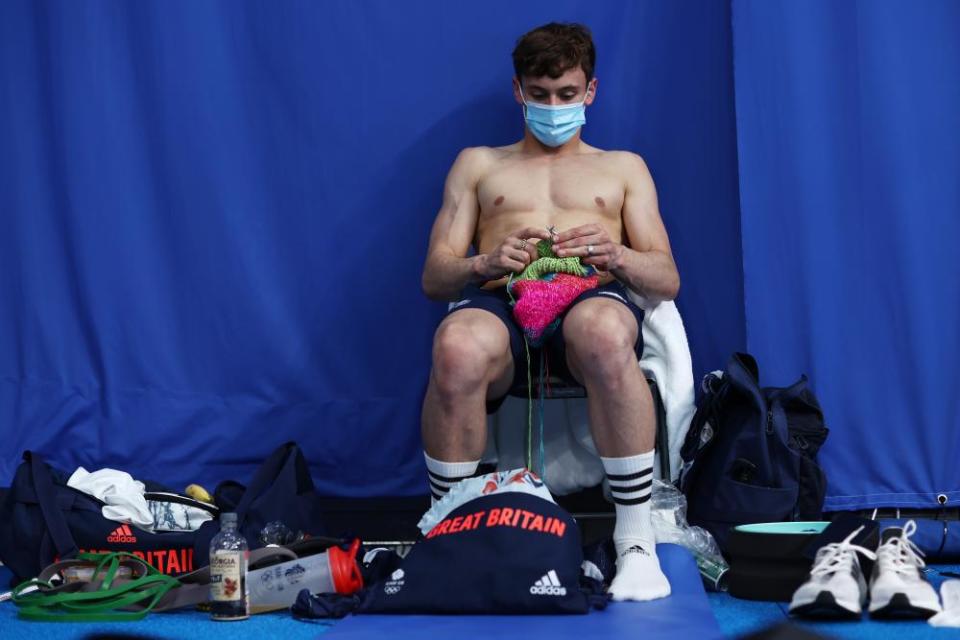
Tom Daley knits before the men’s 10m platform final at the Olympics, Tokyo
Clive Rose/Getty Images
7 August I have been photographing Tom since Beijing 2008. He is a joy to photograph.
This was just before his 10m Olympic final. With the Covid protocols, there wasn’t enough time to go back and chill in the Olympic village, so he just found a quiet corner of the swimming pool, practically under the diving board, and got his knitting kit out.
Him not having his shirt on adds a nice touch, because of the contrast between his masculinity – his washboard abs and athlete’s physique – and how relaxed he looks, knitting away. I just thought it was a nice moment, not necessarily for now, but to look back on in 20 or 30 years’ time.
It was quite a strange Olympics, because of Covid, but for an athlete to start knitting in the middle of an Olympic competition was truly unique. It is very much in keeping with who he is, which is cool. Looking back, people probably remember the whole knitting thing better than him winning his medals. AM
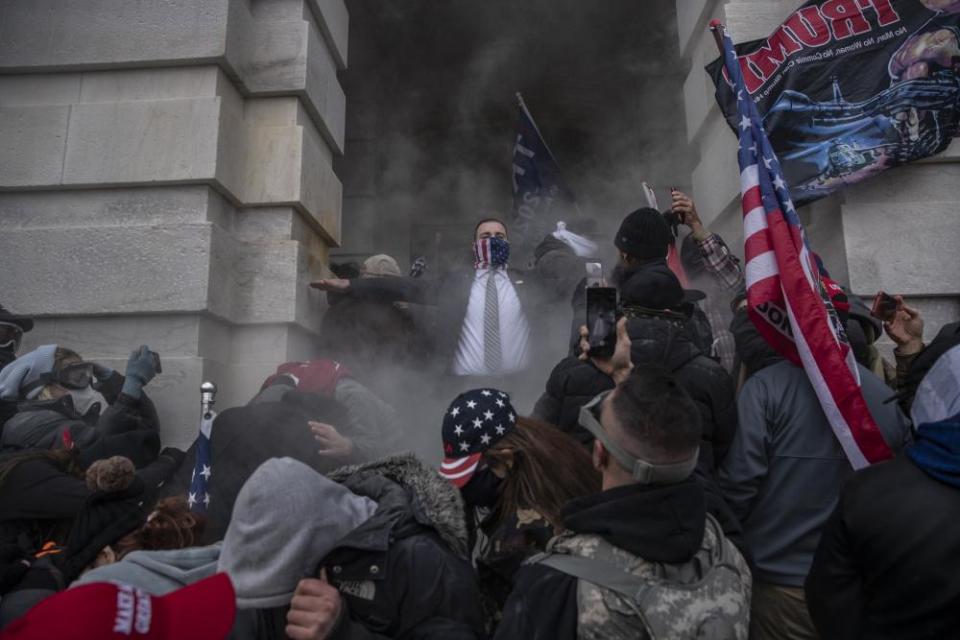
A mob attempts to breach the US Capitol, Washington DC
Victor J Blue/Bloomberg
6 January I had covered a series of large rallies in DC around Trump’s Stop the Steal campaign. By 6 January, we were all prepared for violence around the city, mainly from far right or fascist groups, but anyone who says they knew what was going to happen is a liar.
Trump came on stage to the adulation of the crowd, but after 10 or 15 minutes people began peeling away and marching up Pennsylvania Avenue. Maybe they had just heard it all before, but I felt pretty strongly that I needed to be at the front of that group.
This picture was taken towards the end of the riot, just after they had breached Congress. I had already been inside with the rioters and was very close to the killing of Ashli Babbitt by a Capitol police officer.
The US Congress is a huge building and there were maybe 2,000 protesters trying to breach a set of wooden doors and re-enter the building. Police units inside the building had run out of the chemical irritant they use for crowd control and had resorted to spraying fire extinguishers out the doors. That was when one protester stood at the entrance, spreading his arms in triumph, almost as if to celebrate Trump’s victory in that moment. AM
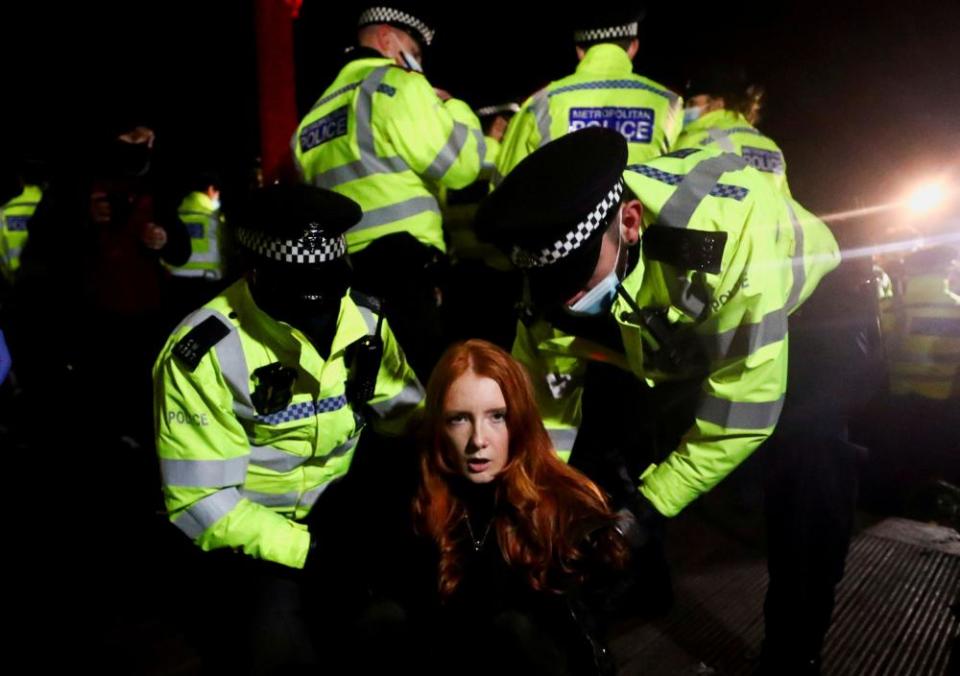
Police detain a woman as people gather after the kidnap and murder of Sarah Everard, Clapham Common, London
Hannah McKay/Reuters
13 March Sometimes London can lack a community feel – you don’t know your neighbours – so seeing so many people, particularly young women, come out for this woman whom none of them knew really added to the sense of emotion on the day. There was a lot of crying.
There was a small group of protesters addressing hundreds of people from the bandstand. As it was still during Covid restrictions, the police eventually arrived to end the gathering, but many were determined to continue paying their respects. It went from a reflective, emotional scene to an angry one. That was when the police and protesters clashed.
I was in the centre of the bandstand when the police began arresting protesters. There was a commotion and I have no idea how Patsy Stevenson came to be forced to the ground, but I have pictures of her on the floor, face down with her hands behind her back.
People have said it looks like a painting – she looks so striking with her pale skin and red hair – but it was pitch black and I couldn’t use flash because of the police hi-vis jackets. There is all sorts of luck involved in the elements coming together in this image.
I think the picture of a lone female protester being restrained by faceless male police officers helped to propel the story into a talking point; it became a symbol of anger. AM
A fisher feeds whale sharks in Tan-Awan, the Philippines
Hannah Reyes Morales/The New York Times/Eyevine
30 September I thought it was really interesting to explore how lockdown measures were affecting the relationship between Tan-Awan, a town in the Philippines, and a species in decline.
Living in the Philippines, you often witness the tension between wildlife conservation and local communities. Feeding the whale sharks has an impact on their nutrition and migration patterns, while the sharks have abrasions from swimming too close to the boats. But the chance to swim with the world’s biggest fish draws tourists to the town. These fishers wouldn’t be doing this if they had more promising economic opportunities, so I don’t believe in making villains of the community for this practice.
I was swimming with the camera, positioning it above and below the water and photographing as widely as I could. To get the entire shark, you have to be quite far away, but not so far that you sacrifice visibility. I find underwater photography challenging – the world is so different beneath the surface. It was important to me to have the shark and the sea warden in the same frame, as this photo is really about a complex interdependence. AM
Tourists watch a volcano erupt, Iceland
Arnar Kristjansson
9 April This was taken just as the second crater started to form. Earlier in the day, I was caught in a massive snowstorm and I was worried there would be no way to capture it on film. But I decided to wait around just in case the snow cleared; you can never trust the forecast in Iceland.
It was weird seeing people standing so close. It can be very dangerous, mainly because of the gas, rather than the lava – if the wind changes direction, then people can get violently ill. There was a teenager taking TikTok videos of himself jumping fewer than five metres away. It was one of those pinch-yourself moments where you capture something truly surreal.
The crater you can see in this photo died within a few days, but some of the others formed from this eruption lasted for months. The one here is the most photogenic, however. I think it is really quite beautiful. AM
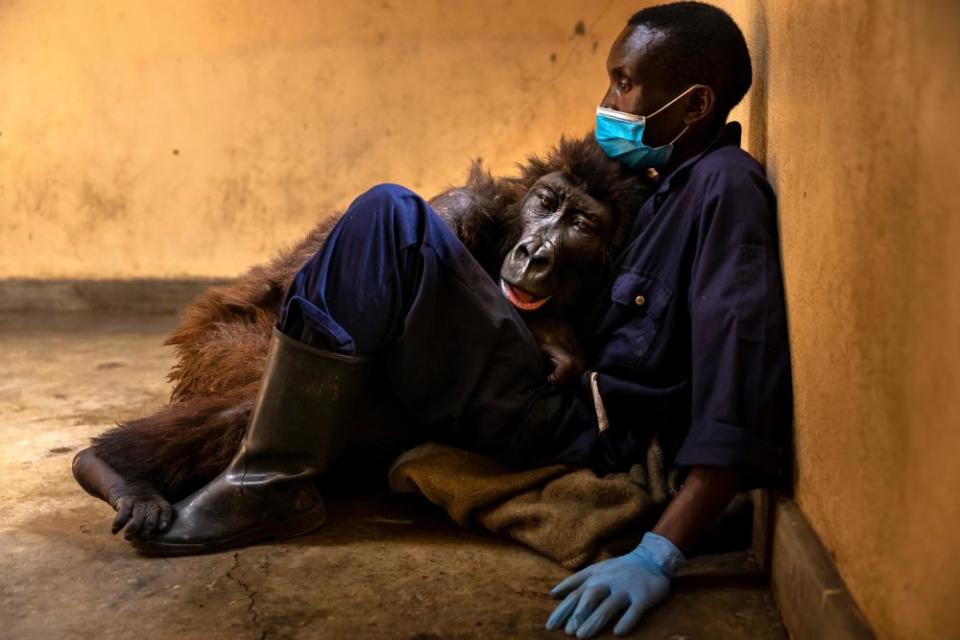
The last moments of an orphaned mountain gorilla, Virunga national park, Democratic Republic of the Congo
Brent Stirton/Getty Images
21 September I have worked with those gorillas for quite a long time. I was in the Democratic Republic of the Congo in 2007, doing a story on how a group of rangers had gone to South Africa for paramilitary training, to combat the various militia groups that were operating in that park. Three days into that assignment, we heard that a group of severely endangered mountain gorillas had been killed. Since then, I have been returning to the park on a regular basis.
In September, I was focused on documenting an operation to clear a group of militias out of the park. While I was there, Ndakasi wasn’t doing well. I went to cover a medical procedure they were doing with her. When she came out of anaesthesia, her caregiver, Andre Bauma, and two vets worked to resuscitate her. After that, she was very weak and crawled on top of Andre. Every part of her was on top of him, the same way a baby would. It was very childlike. The park knew she was very sick, but was hoping she would recover. Then things took a turn.
It was very sombre. Once it was clear what was happening, I shot these frames and left, because it became a very personal moment between her and Andre. She was the only gorilla to survive that massacre in 2007. She was a baby and was found suckling her dead mother. It was very cold and babies can die of exposure very quickly. On that day, Andre became her caregiver. The story is he put her inside his shirt for warmth and walked about four miles through a dangerous area. There is a certain cycle to how she died, being close to him, being held by him again. As told to Emine Saner
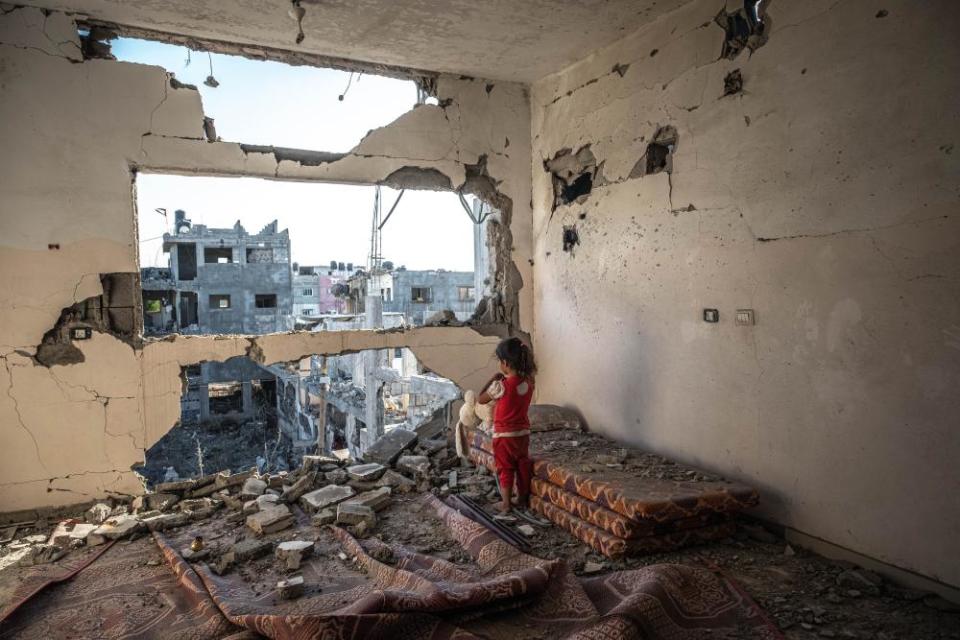
A girl in her destroyed home, Gaza
Fatima Shbair/Getty Images
24 May I was on assignment for Getty Images that day to cover Gaza after the [Gaza-Israel] ceasefire agreement. I headed straight to Beit Hanoun – the neighbourhood had been hit while families were in their homes.
I visited all the families there, heard their stories and went inside the destroyed houses, including the home of Raghad Naseer. Raghad accompanied me from one room to another, carrying her teddy bear. I asked Raghad about her room and she took me to it.
She was quiet the whole time, with signs of shock and sadness on her face. She stood in her room in complete silence, contemplating what had happened to the neighbourhood through the destroyed wall, as if she could not comprehend it. Seeing Raghad in this state was very painful. In this picture, she was expressing the feelings of all the residents of the neighbourhood. It sums up everything that happened.
I visited Raghad again this month. She and her family had to leave the neighbourhood and rent a small house far away. Raghad and her siblings suffer psychologically from what happened; they feel very upset at losing their home and being separated from their neighbours. Taking this picture made me think: my home could have been like this at any moment and I would have lived with the same feeling. I look at the people in Beit Hanoun and think how strong they are. ES
Taliban fighters at Hamid Karzai International airport recite evening prayers, Kabul
Jim Huylebroek/The New York Times/Eyevine
28 August This was taken a couple of weeks after the fall of Kabul. Outside the airport, it was complete chaos; it felt like everyone in the country was trying to get in. Just a couple of days prior, the [Islamic State offshoot] ISKP attack had killed hundreds.
These men are special forces who have been deployed to secure the airport. It was very difficult getting access and, on my previous attempts, I had either been turned away or beaten. That day, I was determined to get in. When night fell, I made my way inside, before explaining to a group of Taliban fighters that I just needed a few photos of them inside the gate.
One guy, the man you can see leading the prayers, started speaking English; he said I might be able to take some after prayers. I asked if I could take them during. Seeing the fighters praying with their modern military equipment, uniforms and helmets seemed like a good encapsulation of how the Taliban had transitioned from a guerrilla force to a modern military operation.
This image is important to me personally, because it vindicated my decision to stay through August. It was a gamble, because we knew things would be uncertain once the Taliban took over, but I felt I had to be there to document the end of the global war on terror as we know it. AM
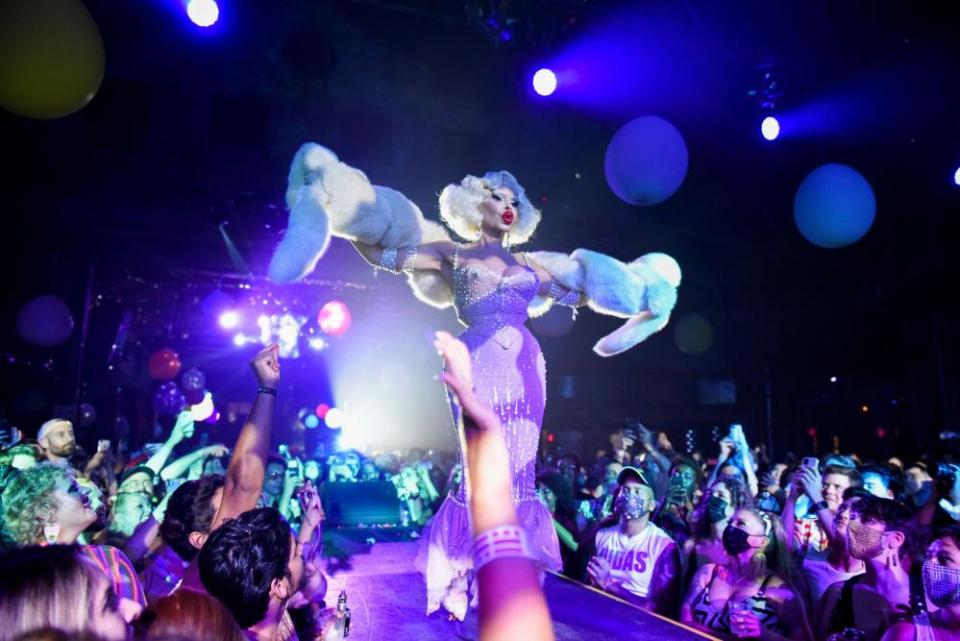
Revellers at Bushwig, a drag extravaganza, New York
Stephanie Keith/Reuters
12 September I attended the first Bushwig 10 years ago and was taken aback; it was freer, more avant garde, than anything I had seen previously. Since then, it has become probably the biggest drag festival in the world, with hundreds of performers over two days. It is a must-do event in New York City queer nightlife.
That is Amanda Lepore. She is quite the character, more icon than woman at this point. When she steps on the stage, everyone just flips out – girls, boys, straight, gay. She stands for everything that is important about drag: embracing yourself and having the ability to be whoever you want to be. AM
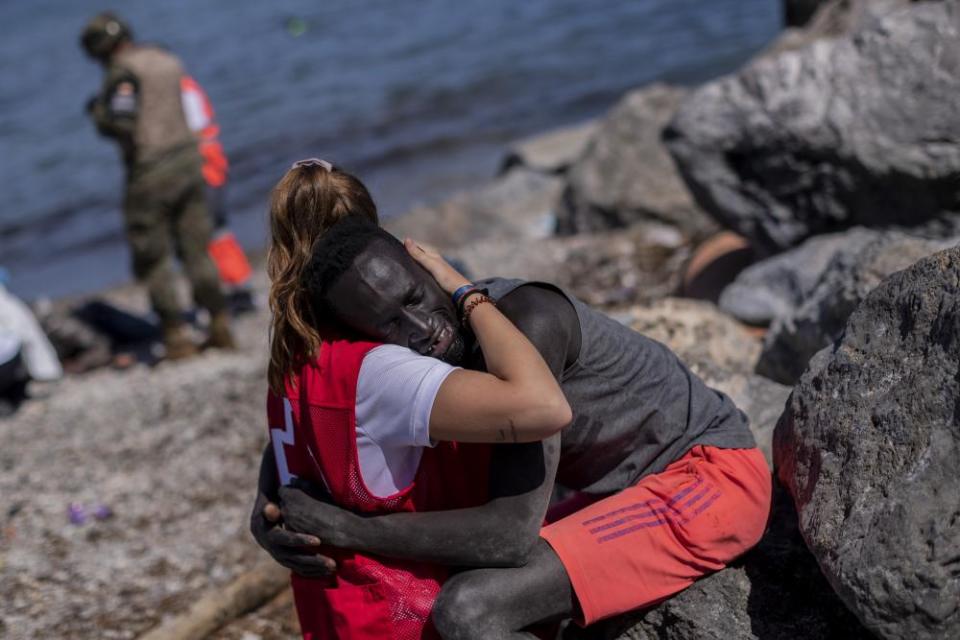
A refugee is comforted by a member of the Spanish Red Cross, Ceuta, Spain
Bernat Armangue/AP
18 May This was taken in Ceuta, one of two Spanish exclaves bordering Morocco on Africa’s Mediterranean coast. Given that politically it is in Europe, it is a long-established route into the continent. On 17 and 18 May, more than 8,000 people crossed over.
This man arrived with his brother, who fell unconscious. He started freaking out, scared that his companion was dying. A member of the Red Cross consoled him, saying everything was going to be OK. It was just one of those moments; he had no choice but to collapse, not only because of the traumatic situation, but also, I imagine, because of the weight of everything they had been through in the previous few weeks.
A lot of the time, arriving migrants do not receive the help or attention they need – it was so great to capture a moment of genuine connection between two human beings, independent of their backgrounds or religions. AM
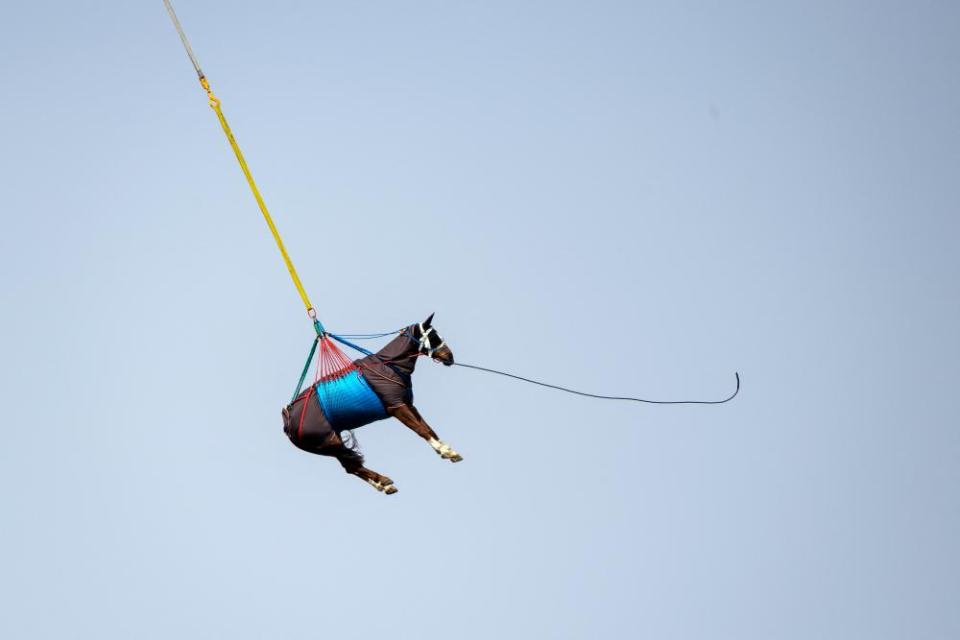
A horse being airlifted by the Swiss military, Saignelégier
Fabrice Coffrini/AFP via Getty Images
9 April I was told the Swiss army veterinary service were carrying out tests and there were rumours that this would feature horses being airlifted by helicopter. I had no idea how that was going to work, but I suspected it might make for a nice picture.
The horses are tranquillised and have their face covered before being attached to the helicopter. Their bodies are wrapped, too, as it gets quite cold up there.
I couldn’t include the helicopter in the shot, as the cable was too long – almost 30 metres – but I think it gives the photograph a surreal air, just seeing a horse suspended like that. It is a very strange image. I think it is improved by not having the context of the helicopter.
The horses are carried over quite long distances, often for more than half an hour. What I really like about this picture is that you can see the movement of the horse – you can almost feel it swinging in the wind. AM
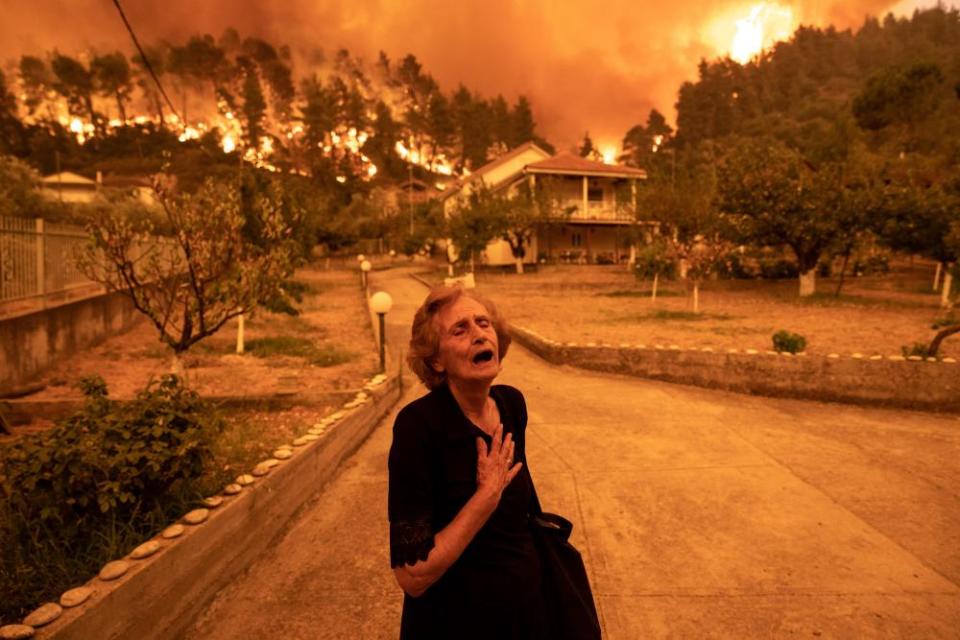
Residents evacuate an island hit by wildfires, Evia, Greece
Konstantinos Tsakalidis/Bloomberg via Getty Images
8 August As soon as I reached the island of Evia, I could see the fires raging in the distance, rising above the sky and burning with this awe-inspiring intensity. You could hear this terrifying crackling sound across the island; it was unlike anything I had ever experienced.
I saw Panayiota Noumidi, 81, moving awkwardly outside the house you can see here. She was clearly distressed, so I approached her. She said she couldn’t find her husband (they were later reunited) and that she was fearful for her home – they had built it slowly over 20 years and it looked like the flames were heading straight towards it (it was not damaged).
It was a chaotic day, but I tried my best to capture the intensity of the fire, the desperation of people in Evia and the lack of government help for those in distress.
I knew straight away the picture was an important reflection of the situation facing Greek people. But I couldn’t imagine it would go viral around the world. It has come to symbolise the climate crisis, with the catastrophic damage caused by the fires representing the damage that human activity is doing to the planet. For me, it is very special to take a photo that affects so many people around the world. AM
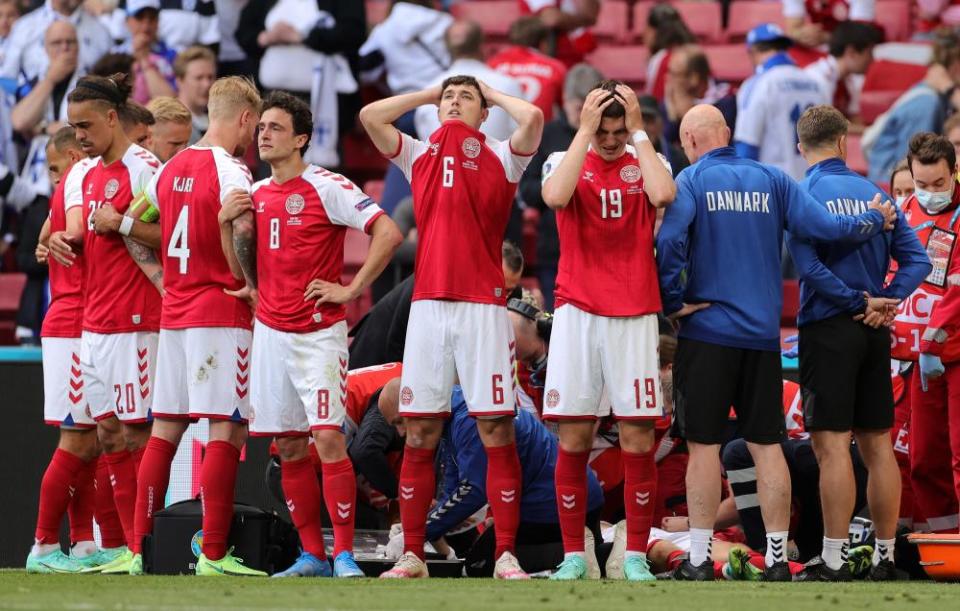
Denmark footballers form a human shield around their teammate Christian Eriksen at Euro 2020, Copenhagen
Friedemann Vogel/EPA
12 June This was taken roughly four or five minutes after Eriksen collapsed. At the moment I took this, no one knew if he was even alive.
I tried to maintain distance throughout. Uefa’s Covid rules prevented me from going on to the pitch, but, regardless, I felt it was important not to do anything that might interfere with the medical team’s work.
I got a lot of criticism for this picture, for trying to get a shot of someone who was potentially dead, but it is my job. It is really important to show the reality of the situation. Seeing the fans hoping and praying was so powerful. Regardless of nationality or support, everyone just wanted Eriksen to be OK.
The faces of the players around Eriksen are unbelievable. They can clearly see how serious the situation is and they are extremely distressed. Restarting someone’s heart is incredibly difficult; when you see it up close, as I could, you realise how much every moment matters. AM
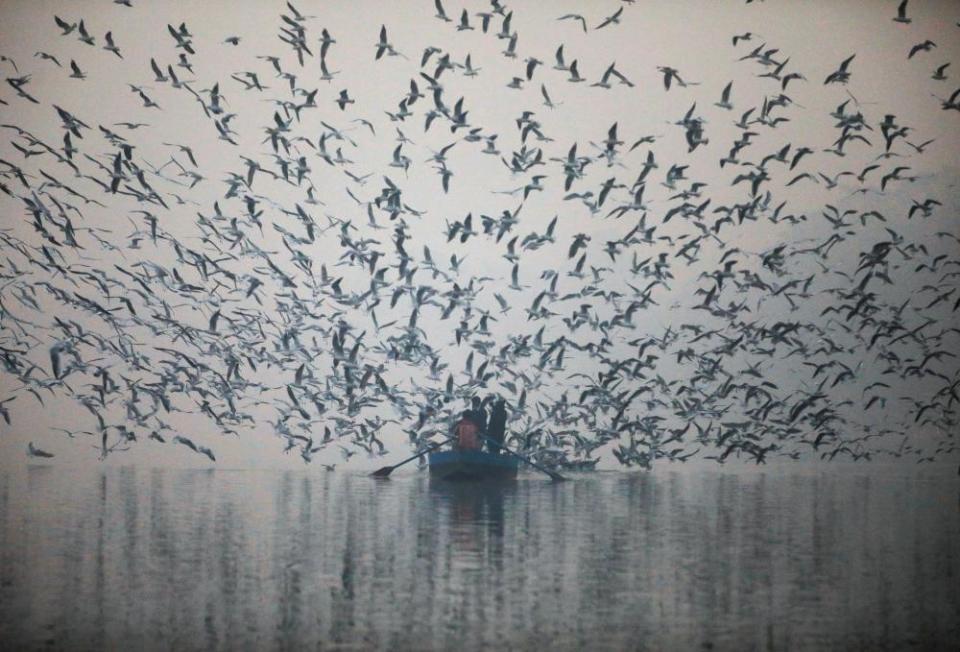
People feed seagulls in the smog, Delhi
Navesh Chitrakar/Reuters
18 November From the moment I arrived in Delhi, my eyes burned from the thick smog. I wasn’t there for work; it was more of a holiday, with my wife, so I took the opportunity to spend a few days waking up early and getting out to take pictures. After I came back from the shoot, I went through all the pictures and almost didn’t bother to file this one. But I asked my wife: “Which picture should I go with?” and this one was her selection. The initial story was about the pollution, but for me this picture is all about the birds; they look so dramatic against the smog-filled backdrop. AM

 Yahoo News
Yahoo News 
